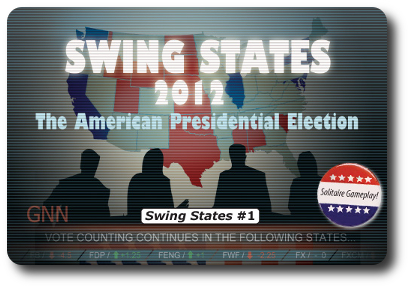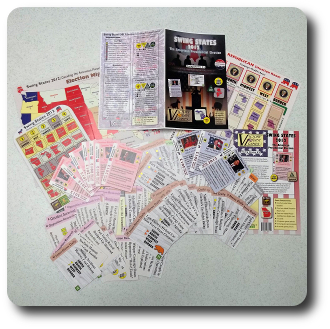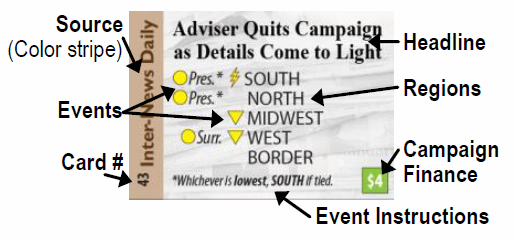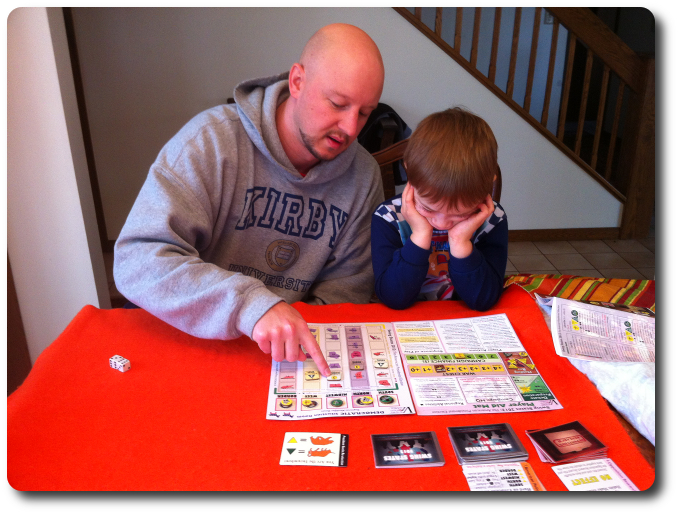
The Basics:
- For ages 12 and up
- For 1 player
- Approximately 40 minutes to complete
Geek Skills:
- Counting & Math
- Logical & Critical Decision Making
- Reading
- Strategy & Tactics
- Risk vs. Reward
- Hand/Resource Management
- Worker Placement & Area Control
Learning Curve:
- Child – Moderate
- Adult – Easy
Theme & Narrative:
- Take on the role of a political strategist and help your nominee be elected to the office of President of the United States of America
Endorsements:
- Gamer Geek approved!
- Parent Geek rejected!
- Child Geek rejected!
Overview
You have been hired to claim the White House. At your disposal are all the resources you will need, but not unlimited. You have one year to “sell” your nominee to the people of the United States and win them over. There are 25 states in five different regions that are up for grabs and have just become your battlefield. Fight to win and then to keep them as the opposition and the media work against you. Of course, every good political strategist knows that timing is everything, and a scandal or two could always be beneficial in the long run. Just remember that there is no second place and the stakes couldn’t be higher!
Swing States 2012, by Victory Point Games, is comprised of 1 Situation Room mat (double-sided, Republican on one side and Democratic on the other), 1 Player Aid/Election Night mat (double-sided, player aid/organization boxes on one side and map of the Unites States on the other side to help count final points), 75 cards, 32 square markers, 5 triangular markers, and 6 round markers. Needed to play, but not included with the game, are 2 six-sided standard dice. The box version of the game (we are reviewing the version that comes in a plastic bag) comes with 2 six-sided dice.

Example of what is included in the game
Game Set Up
To set up the game, first determine which political party you will be the Campaign Manager and political strategist for. Place the Situation Room mat on the corresponding side (Republican or Democratic) face-up.

Situation Room mat (the reverse side shows Democratic)
Second, collect all the cards and organize them into their specific decks. This is easily done by flipping them over and looking at the card’s face. Each card has a colored stripe that can be used to quickly separate the cards. At this time, remove the Extra Surrogate and Candidate cards from play.
Third, select one the Election Year Situation cards (black stripe) that best describes the game you want to play. For example, no incumbent running for office and you are representing the Democratic party. Place the selected card nearby for reference and the other card is removed from play.
Fourth, turn the Opposition Research cards face-down and shuffle. This is now referred to as the Opposition Research deck.
Fifth, turn the Inter-News Daily Headline cards face-down and shuffle. Deal 13 cards, face-down. This is now the referred to as the Event deck. The remaining Inter-News Daily Headline cards are removed from play.
Sixth, turn the American Politics Headline cards face-down and shuffle them into the Event deck.
Seventh, turn the Campaign Watch Headline cards face-down and shuffle. This is now referred to as the Reserve deck.
Eighth, take the Regional Strategy markers (Campaign side face-up) and place them on the starting states on the Situation Room mat. Once placed, determine which of the five regions on the Situation Room mat your political party is holding its political convention. Flip the Regional Strategy marker in this region over to show the Advertising side face-up.
Ninth, place the Presidential and Vice-Presidential Nominee markers in the same region as the Regional Strategy marker that is flipped to the Advertising side. Make sure that both Nominee markers are flipped to the Used side.
Tenth, to the left of the Situation Room mat, place the Player Aid mat with the United States map side face-down. Place the Campaign Finance and War Chest markers on their starting position.

Player Aid mat (the reverse side has a map of the United States)
Eleventh, set aside the 25 Swing State markers at this time as they are not used until the end of the game. All the other markers can be placed to one side or in a small reserved area on the Player Aid mat. The deck of cards can be arranged in anyway that is most convenient for the player.
That’s it! Grab your dice and get ready to make history!
Playing the Political Game
Note: While the game itself is not difficult to play, the rules are fairly lengthy and there is a lot to consider during every game turn. As such, we will only summarize the sequence of play here and encourage you to read the full rules (available from the game’s official web page) to learn more.
The game is played in turns with each turn broken down into five sequential phases. These phases are summarized here.
Phase 1: Refresh
During this phase, all the used markers are flipped over to show they are now ready and available. Any Nominee markers that were used during the last turn must also travel to a new location. Any Nominee markers that were not used during the last turn can move if the player wants. After adjusting all the markers, the phase ends.
Phase 2: Headlines
During this phase, the top card from the Event deck is drawn and read. If the revealed card is a Headline card, it becomes the Current Event card, replacing any older Event card in play, and must be resolved during this turn. If there are no cards left to draw from this deck, the endgame is triggered.
Phase 3: Event
During this phase, the Current Event card is resolved. The Opposition marker will be placed or relocated and then the player will complete the actions noted on the card from top to bottom. Influence in different regions might go up or down and additional financial funds will be gained. Once the actions on the card have been completed, the phase ends.

Phase 4: Action
During this phase, the player will be taking specific actions to react to recent events, regain lost political ground, and make tactical decisions on how best to proceed. This is done by spending campaign funds and playing cards. A player can advertise in a region (go offensive), shift gears to campaign in a region (go defensive), attempt political damage control, conduct research on the opposition (in hopes of digging up some embarrassing dirt), and manage their campaign funds. Once the player has completed their actions, the phase ends.
Phase 5: Scandal
During this phase, the Scandal marker’s placement influences the region and the Campaign Strategy marker in it, adjusting its location.
That completes all the steps and a single game turn. Again, we only summarized them here. There is much more to the game, specifically during the action phase. During the action phase, the player is asked to do a great deal of strategizing and make tactical moves.
If the Event deck still has cards, a new turn begins and starts with phase 1.
Election Night
When the last Event card is drawn, the game (and election) has entered into the “Home Stretch”. The remaining cards in the Reserve deck are now used during phase 3. Once all of these cards are played, it is Election Night and all the player’s hard work is now put to the test.
The Player Aid mat is flipped over to reveal a map of the United States of America. Any markers on the Player Aid mat can be removed as they have no impact to the endgame scoring. The 25 Swing State markers are now placed on the map in their matching map space with their red or blue side face-up, as determined by the following:
- The player wins the state (placing the color that matches their political party face-up) if the state is BELOW the region’s Campaign Strategy marker on the Situation Room mat.
- The player loses the state (place the color that matches their opposition’s color face-up) if the state is ABOVE the region’s Campaign Strategy marker on the Situation Room mat.
- Any state that has the Campaign Strategy maker on it and any state that is directly above or below the Advertising Strategy marker are considered a “toss-up” and must be rolled for.
Once all the states have been accounted for, count up each state’s Electoral Votes for and against your political party. Note that not all states give the same number (Texas is worth 38 Electoral Votes, for example, and Minnesota is worth 10). If the total Electoral Votes won is 270, your candidate has won the election! If not, you’ve got 4 years to get ready for the next political battle. Or, in game terms, about 5 minutes to reset the game and try again.
Game Variants
The following game variants are available to play with that change the normal game described above.
- The Candidate Game: this game variant turns the normal game into something of a simulation as the player gets to play with the Candidate cards. A Presidential and Vice-Presidential candidates for both parties are selected. Additional game set up is required and, depending on who was selected, the game balance will tip. This game variant is only recommended if the player wants to see if they can change history, game-wise.
- The South May Rise Again: this game variant is an optional rule that allows the Border Region to influence the South Region.
- The Pundit: this game variant is a scenario that allows the player to build the Event and Reserve deck, thus crafting the game’s possible outcome.
- Build Your Own Candidate: this game variant allows the player to build their own Candidate (instructions included in the rule book) using a point system to assign advantages. Use this created Candidate with the Candidate Game variant.
To learn more about Swing States 2012 and read the full rules, visit the game’s official web page.
Prediction
Essentially, Swing States 2012 is a war game. Instead of troops and bullets, the player is given money and campaign speeches. In some cases, this is as dangerous as any army, but not nearly as lethal. What this means is that the game must be played using a great deal of focus, strategy, and tactics. This makes it a game that is automatically “not light”, but because it is a solitaire game, it is automatically casual. Since there is only one player, the game can take as long as needed without worrying about the clock running out.
This will also make the game very hard to test with our three groups, the Child, the Parent, and the Gamer Geeks. Games that allow for 2 or more players are pretty easy to get to the table. Games that take one player are most certainly not. This means the game will have to be tested during those rare moments when I have a friend over and they are more than willing to take the time to play a game by themselves while I watch them (which could be creepy). I think, however, the best way to handle this is to simply give the game to others, ask them to write down their thoughts, and then sit down with me to go over them.
In fact, this is exactly what I did. I gave the game to 3 Parent Geeks and 2 Gamer Geeks. I asked them to learn the game, play it, and then teach it to their families. I did the same. By approaching the game in this way, I should be able to get a very good idea what the three test groups think of it. And so, after learning to play the game myself, I sat down with my little geeks to teach them the game. After I did so and went through a single turn to demonstrate the game play, I asked them their thoughts on the game so far.
“Ugh.” ~ Liam (age 8)
“I don’t get it, Daddy.” ~ Nyhus (age 5)
Well…not a very promising start. Let’s play the game and see if it wins their endorsement or is voted off the table.
Final Word
This game was not approved by any of the Child Geeks who played it (ranging from ages 5 to 13). They reportedly found the game “long and boring”. What they really didn’t like was that the game was meant for one player. This really turned them off the game and I don’t blame them. Asking a Child Geek to sit down and play a game by themselves for over 30 minutes is asking for a great deal. Not very realistic, in fact. When the Child Geeks played with the Parent and Gamer Geeks (cooperatively deciding what actions to take), their level of interest improved, but never to a point where they wanted to play the game again.
Parent Geeks were intrigued by the game, but were also turned off by the game’s intent to only be played with a single player. They all agreed, however, that it was a well designed game and did an excellent job of what they thought a Campaign Manager would have to do during a campaign year. They also believed the game would be excellent for classrooms and for anyone who enjoyed politics. But, in the end, they didn’t much care for it.
Gamer Geeks rather enjoyed this game and saw it as more of a wargame than a political one. They greatly enjoyed the level of detail and freedom the game provided, allowing for complicated strategy and tactics to be used. Each play session was tough and wins were always fought for. The challenge and the relatively short time spent to play the game sealed the deal and the Gamer Geeks happily endorsed it.

A great image that demonstrates just how “entertaining” this game was to the little geeks
Gamer Geeks, your peer group found this game to be simply outstanding. The game is tough, but fair, and a real challenge to win. The game is surprisingly deep and there is much to consider, but the game play flow is easy to follow. The battlefield is very large and you will need to balance a great deal to maintain and gain ground. While this is a game about politics, if feels like a wargame. Defensive and offensive actions must be taken to successfully encounter and mitigate harmful change or take full advantage of a sudden windfall. The game never lets up, plays fast, and will keep you on your toes. Do not expect to win this game at first, or even the second time, as you manage your resources and stave off the ever looming threat of defeat.
Parent Geeks, your peer group didn’t care for this game for three reasons. First, it is a game meant to be played with one player. That’s not very “family friendly”. Second, while playing the game with a family member is totally possible, the game length and game play style is not engaging enough to keep 2 or more players entertained. Third, the game is very difficult to win. So difficult, in fact, that none of your peer group members won this game in the five times it was played. This just lead to more frustration and, eventually, totally turned your peer group off.
Child Geeks, this is a game of politics and a very difficult one at that. This game was not approved by your peer group on account of that it didn’t make sense, took too long, and was “no fun”. When you get older, realize the world is a much bigger place, and there is such a thing as “government”, you’ll start to understand this game a bit more. Until then, set this game aside.
To date, this is the most challenging solitaire game I have ever played. I always feel like I’m doing really well, but then come up short when I count my final Electoral Votes. This is both frustrating and encouraging. Frustrating because I can’t seem to work out a solid strategy for victory and encouraging because I can see myself improving. And it is the learning and improving aspect of the game that I am really enjoying. Because the game is played with just one player, I can take the time to really think about what is going on, how best to address it, and then see how things go. There is never any stress, but there is a great deal of what feels like duress. Often, I would become terribly discouraged when I suffered a huge hit from a scandal that I couldn’t seem to recover from. Seems silly now, but I was scrambling like crazy trying to do damage control and regain influence in key states for Electoral Votes. I can’t say this game made me cry, but I did walk away from the table a number of times and considered flipping said table more than once.
The game is a good one, does an excellent job of challenging the player, is well designed, and is the best example of how complicated and fickle our political system is without being a complicated or fickle game in itself. In fact, I appreciate what political strategist have to go through a whole lot more now, without actually appreciating the candidates any more or less. This political game is a hard one to win, but it can be mastered. A player who is able to look at the big picture and able to make small movements to obtain big gains will certainly get their candidate elected. The trick is learning this magic. Until then, everyone else will be left well outside the winner’s circle.
From an educational standpoint, I think Swing States 2012 could be leveraged as a very entertaining exercise and educational experience for students. This is especially true when we consider the game variant that allows for specific Candidates to be used or created. Imagine how much fun and interesting a political lesson plan could be if it included an opportunity for the students to create their own Candidates and then follow them along in the game as real-world events impact the game play. I can think of no better way of demonstrating how the political system works than seeing it come to life in front of you. Additionally, because the game does allow for the creation of Candidates, Swing States 2012 will remain fresh well after 2012, making it a game that could be played for years to come without ever feeling irrelevant.
Finally, a quick word on the game design. For a game that deals with politicians, there is surprisingly little politics to deal with. The game has removed the mud flinging and broken it down to defined actions that “suggest” what is being done. This makes the game much more abstract, of course, but I always felt like I was playing a wargame instead of being trapped in a political circus. When my candidate was attacked, I attacked back. When I gained a strong foothold in a state and improved my candidate’s standing in a region, I did all I could to defend it. This made the game much more enjoyable for me as I was never asked to listen in on the “political noise”. This freed me up to focus on moving my game pieces forward, enjoying the challenge of fighting influential skirmishes and winning popularity battles. The only regret I have, honestly, is that this is a game I wont’ be playing with my little geeks anytime soon.
If you are looking for a challenging game of winning (and then keeping) political influence, where every decision is given to you to decide, then do get your hands on Swing States 2012.
This game was given to Father Geek as a review copy. Father Geek was not paid, bribed, wined, dined, or threatened in vain hopes of influencing this review. Such is the statuesque and legendary integrity of Father Geek.




Now that the 2012 elections are over, this game is a lot less personal without being any less fun.